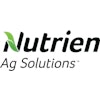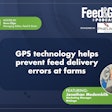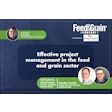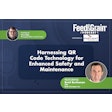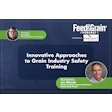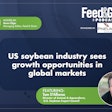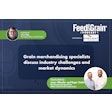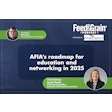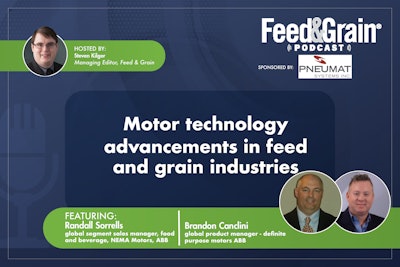
In this episode of the Feed & Grain Podcast, host Steven Kilger interviews ABB's Brandon Canclini and Randall Sorrells about the latest developments in motor technology for the feed manufacturing and grain handling industries. The experts discuss new efficiency standards, the benefits of upgrading to IE4 and IE5 rated motors, and the importance of predictive maintenance using smart sensors. They also explore how integrated motor drives and improved reliability are shaping the future of industrial motors. This informative conversation provides valuable insights for industry professionals looking to enhance their operations and reduce downtime.
Steven Kilger - 00:01
Hi everyone, thanks for listening. My name is Steven Kilger, I’m the managing editor of Feed & Grain Magazine and the host of the Feed & Grain Podcast. Thank you so much for joining me today as we dive deep into the issues affecting the feed manufacturing, grain handling and allied industries.
Today’s episode is brought to you by The BinWhip from Pneumat Systems. The powerful Dual Impact BinWhip removes the toughest buildup and blockages in industrial storage silos – without hazardous silo entry. Learn more today at binwhip.com.
Today my guests are Brandon Canclini, global product manager - definite purpose motors and Randall Sorrells, global segment sales manager, food and beverage, NEMA Motors for ABB. We sat down to talk about advancements in motor technology, including efficacy, sanitation and new technologies.
I hope you still enjoy the interview. If you want to help out with the podcast and are listening to this in a podcasting app, please rate us and subscribe! If you’re listening online, sign up for the Feed & Grain Newsletter Industry Watch to see when new podcasts drop and stay up to date with all of the news from around the industry.
Now onto the show.
Thank you, Brandon. Thank you, Randall, for joining me today. I really appreciate it.
Why don’t you guys just tell me a little bit about yourselves and what you do at ABB and kind of your connection to the industry?
Brandon Canclini - 01:14
I’ll go ahead and start. My name is Brandon Canclini, global product manager - definite purpose products. I’m responsible for our wash down and farm duty products. I’ve been in the role for about 12 months now. I came from a project management background. I ran a lot of product development projects prior to moving into this product management role and I guess that’s real.
Canclini - 01:41
I’ve been with the company now for 15 years.
Started off as a quality engineer and a couple of our different manufacturing plants and then through the years just moved into different roles.
So that’s my story.
Randall Sorrells - 01:54
I’m Randall Sorrells and I’m the global head for food and beverage segment sales for NEMA motors. And so I’ve been in this role now just under a year, but I’ve been with ABB since 2012. And then of course been in the industry much longer than we’ll want to really talk about. But anyway, so my background is automation. So packaging and automation, PLCs, drives, motors, anything to do with the plant for automation. And so that’s my background coming into this. I’ve worked in all different segments in all my career. But of course, anything food and beverage has always been a big part of that.
Sorrells - 02:34
Pharmaceuticals, poultry, many other, of course, direct food and beverage. So that’s my background. And then coming into this, being able to focus 100% in this sector is very important.
Kilger - 02:47
Yeah. When I think of ABB, I think of motors, obviously, and in our industry, feed and grain handling, feed manufacturing, grain handling, it’s really the heart of the entire facility.
Your motor is the most really important thing, it leaves everything, powers everything, it’s what you need. What, if someone hasn’t upgraded their motors in maybe 10 years, if they haven’t made any upgrades to their system, what new have you guys been doing that might convince them that this is the time, that it’s important for them to upgrade now versus in the future waiting another five years.
Sorrells - 03:25
So if you don’t mind before I answer, we totally answer the products, which Brandon can cover. Let me, if you don’t mind, let me talk leading into that. So let’s talk about how everything has changed in general. So at this point, we’re sitting at a scenario to where, let’s say close to 20%, definitely not exceeding much of that, is the motors are now controlled by VFDs. And so what that means is with the VFD you can now start controlling your process rather than your process so much controlling you. So by this trend been able to come to us over the years with technology the cost of automation coming down in general like I said that’s my entire background. It’s allowed us to be able to take various technologies into other parts of the industry
Sorrells - 04:18
And so we’re looking at process controlled, but now we’re actually starting to really look at process efficiency as well. And with all that, you’ve got the total cost of ownership that you must look at. So not only the inception cost of the units, the widgets itself, but what’s that going to cost you for the entire life of that equipment? So that kind of leads then to where are some of our products and Brandon if you don’t mind maybe just taking it off with some of the stuff that you’ve released. Okay.
Canclini - 04:51
This past year we’ve really been involved in a lot of product launches really aiming for a lot of it being our brand new SP4 product line. So we’re basically addressing a regulation that’s not going to go into effect until June of 2027. It affects the horsepower ratings from 100 to 250 horsepower and it’s going to require those motors to operate at an IE4 efficiency rating. We’ve gone ahead and taken the initiative to release this new SP4 product which is IE4 rated. We’ve gone ahead and released it and it’s from we’ve got basically one through 300 horsepower that we’ve gone ahead to because we know that customers are going to be looking into the future and starting to plan for what application needs are so they have the ability to go ahead and incorporate the new high efficiency motor into those applications. So really excited about that.
Kilger - 05:54
For people who might not know, what is this regulation, what is happening with it?
Canclini - 05:58
Yeah, it’s like I said, it’s going to be June of 2027. It’s going to require from 100 to 250 horsepower to operate at an IE4 rating. It’s going to be a mandatory and can you think of anything else from a requirement standpoint?
Sorrells - 06:15
I think there’s some main requirements. If you don’t mind, let me explain this with an analogy. So some of us that have been in the industry for a number of years are starting to date ourselves and this whole analogy might help a little bit. So if you think about fluorescent lights, so we used to have the big fat 8-foot-long, what was called the T12 fluorescent lights. When the more efficient bulbs started coming onto the market, basically the discussion was for every hour that we’re still burning the T12 lights, it was costing money. Okay. And at that point, it became very costly to keep the T12 rather than talk about upgrading.
Sorrells - 06:58
And so that’s where we are with the motors so our technology with the motors so the mandates are pushing us to let’s say a different type of light bulb so to speak but we’re talking about motors which use a lot more electricity than what light bulbs do and so this is taking us to where we need to use more efficient motors and so that’s what we’ve released. Brandon’s talking about is that IE3 that so the IE3 was what the standard was for many years. IE4 takes it to the next efficiency band and then IE5 which you’ll get to a bit is even on beyond that. Hopefully that analogy helps explain it just a little bit.
Canclini - 07:38
No, it’s perfect.
Kilger - 07:38
Department of Energy that is such these regulations Yeah, it seems like it kills two birds with one stone, right? Because also, mills, grain evolution, we’re trying to be more efficient, not only for the story to the public that we want tell, the money that you’ll save in an industry that is increasingly getting tighter and tighter margins. So, can you tell me a little bit about what I guess the upgrade process is? Say you already have a mill, you need to get these new motors, how do suggest people start going about that process?
Canclini - 08:12
One of the things that we made sure when we released this SP4 product, we made it to where it’s a drop-in replacement. So it follows the NEMA frames and we offer it in standard mounting as well as the C-FACE mounting. So It’s going to be really easy to find a similar product that meets application requirements. So where they just pull the old motor out and drop the new motor in and boom, they’ve got their starting savings.
Kilger - 08:42
Awesome. Another thing I’ve noticed is, well, your background’s in automation. You guys have been increasing the information you can get from a motor the more data you can get. Can you talk a little bit about what kind of data people can get and how that can be useful for them running their own?
Sorrells - 08:59
Absolutely. And lot of it depends on how you’re connected as well, because as we talked about that 20% that’s having VFDs on, we get information directly from the VFD, but we’ve taken it to the next step and we offer what’s called a motor sensor, the smart sensor to where it’s a, basically it’s a health monitor that sits directly on the motor that’s gathering information, start, stops, vibration, RPM, speed variations, so it’s an excellent tool. But then, so that data is available to anybody that buys the smart sensor, but we take that then to the next step. So think of that as like a wrist worn health monitor, okay, which is good, but we offer an additional service that’s utilizing that data that kind of steps it up to an EKG because then we have doctors behind the scenes reading the charts so that they’re interpolating that data. So it’s data otherwise, but then they’re adding the intelligence to it.
Kilger - 10:02
So we can take it to where it’s at that point, truly condition monitoring Which is important, I think, because a lot of people, they get the data and then they have no idea what to do with it, what any of it means. That is correct.
Sorrells - 10:15
Because data is data until you know what it means, right? So it’s just like, for example, if I have to go for MRI, they’ll give me a DVD or whatever with those MRI images on them. I don’t have the skills to make heads or tails of it and so that’s where our additional service takes it on to being able to do truly read it and interpret that data It’s really cool especially things like vibration monitoring which I always found really fascinating because it’s one of those things
Kilger - 10:45
A lot of people think that they could just see or they could just think but these sensors can have so much more data about your facility than you’d ever be able to just monitor yourself and when you’re talking about condition monitoring we don’t to see it you’ve got to have some catastrophic right
Sorrells - 11:02
So what we’re wanting to do is be able to detect it well before a failure and do predictive maintenance right so that’s where you can’t see it you can’t really fill it with human touch that’s why these sensors become so valuable in that predictive maintenance side of things. Unclaimed downtime is very costly.
Kilger - 11:24
Oh, yeah. Unclaimed downtime is, it’ll ruin your, it could ruin your Fordham.
It really could.
Multiple speakers - 11:31
Very easily.
Sorrells - 11:33
At the bottom the day, so every single one of our customers, all the end users, they’re running money machines. They’re stamping out $100 bills and so it’s very important to keep those money machines running you know and so any downtime that you can prevent okay so you may have to pay a nickel more for this or that but if it can prevent that downtime what’s it worth at that point so then you start have to start looking at can you afford not to invest to that. And that’s one of the big things that we’re helping to work with our customers is being able to distinguish between what’s an investment and what’s an expense.
Kilger - 12:12
What else have you guys been working on this over the last couple of years? Maybe even some future stuff you’re working on. What do you guys got?
Canclini - 12:18
For washdown products, we recently released a three leaded version of our FoodSafe product. Our standard FoodSafe has nine leads and we reduced that to a three lead on 460 volt applications only. So what this does is reduces the installation time and also reduces the complexity of the installation by reducing the opportunity to accidentally misconnect the motor to the application. Another thing that we were just now releasing, in fact, this week, is our brand new FoodSafe SP5 Plus and what that is that we integrated a ferrite assisted synchronous reluctance rotor into our standard winding and what we’re able to achieve is an IE5 efficiency rating so we’re really starting to explore a lot of different designs to really push that efficiency level up and so really excited about these new products that we’re bringing to the market.
Sorrells - 13:28
And while I have experts here, unless you have something to listen Oh, I can go on and I’m more than glad to So a couple other things too I want to point out is that’s new for us is and I want to tag on to the discussion earlier about the SP4 product that he released. So the SP4, so as a standard part of that offering and correct me if I’m wrong, Brandon. But so for anything that’s like for the grain industry, you get into explosion applications, right? So by default in our standard product, we have that certification built into that product. So again, it’s bolt in, like you said, bolt in replacement but it’s good for VFDs and non-VFDs and being able to also take care of those explosion-proof applications.
Multiple speakers - 14:18
It was on a specific SP4 product line.
Sorrells - 14:22
It’s our severe duty and it’s rated for DIP II, Class II, and G. And then also we’ve Over the past year or so we’ve been in the process of releasing a series of products which is called our Integrated Motor Drive, so our IMD. So this is motors with VFDs directly coupled and attached to those motors. And so those attack both the application, so again controlling the application, but also the energy efficiency. So you’re talking about the SP5 product that he mentioned with FoodSafe. So we’re doing that same technology on those IMDs with the VFD on it. So it is literally the most efficient package on the market that you can have right now. But anyway, so that’s a part of our portfolio that we’re continuing to launch as well.
Kilger - 15:13
I have to ask, what are you guys excited about for the future? What do you think is kind of the next big thing you think this industry going to see in motors in five years?
Sorrells - 15:24
Good question. Of course, what we’re constantly pushing the envelope on is reliability. Because again, you can get a cheaper widget out there, but if you’re having to take it, replace on very regular interval, especially if you have any social conscience as far as carve a footprint. It takes a lot of energy and a lot of resources to first make any mode, right? So if you’re having to replace it on too regular of an interval, what’s that doing? And that’s before you even start talking about the energy consumption of the motor itself.
Kilger - 15:59
And the downtime of needing to replace and all that other kind of stuff.
Sorrells - 16:02
That’s right. And the expertise and the resources. So that’s one of the areas that Brandon and his team is really bringing to us in the sales side is so that we can take to the customers is that reliability, making sure that we are building the most reliable product on the market, but doing so without sacrificing, but actually elevating the technology for us to leverage in energy efficiency. So combining those two and frankly makes it very exciting for me to go out and talk to customers.
Kilger - 16:30
Awesome. So if people want more information, where should they go?
Sorrells - 16:40
So the, so of course there’s a number of ways to reach us, but we’ve got a number of fantastic channel partners that handle our products. But the other great thing is we have a, what’s called a district office network. That’s all over the country, so within literally an hour or two of anywhere. So I highly encourage everybody to go to abb.com and then drill down through the motors portion of that. As you can imagine, with anything else, URLs are a little hard to verbalize, but drilling down through abb.com is one of the best ways.
Kilger - 17:17
And I’m sure you can ask it, reach out and ask questions and things like that. Absolutely, yes. But because I’ve been to their website, those motor numbers.
Sorrells - 17:25
Yeah, so the best thing is because we are not just a dot com and good luck kind of company. We are all about being able to come in, sit down, have a conversation, walk people through and making sure the right application and the right products come together for the right solution. And that’s what we’re all about because again. We’ve been around a long time, we intend on being, and dump and run is not the way we play things.
Kilger - 17:54
You also have a great blog too, from what I remember, so people can find more information about things there, and it’s a good resource.
Canclini - 18:01
We’re on, we have YouTube channel, we have, we’re on various social media platforms and accessibility to our product information, going to our, like I said, like Randall mentioned, going to our website. You can find a lot of information available for each one of our product groups.
Kilger - 18:20
Awesome. Thank you guys so much for talking to me today. I really appreciate it.
Canclini - 18:24
Thank you. Thanks for the opportunity.
.jpg?auto=format%2Ccompress&crop=faces&fit=crop&h=48&q=70&w=48)

